Shock new twist in Gympie UFO mystery
The thing smashed through their roof at an alarming speed, cracking their floor as it made impact. But weeks after this phenomenon made international headlines the mystery has deepened.
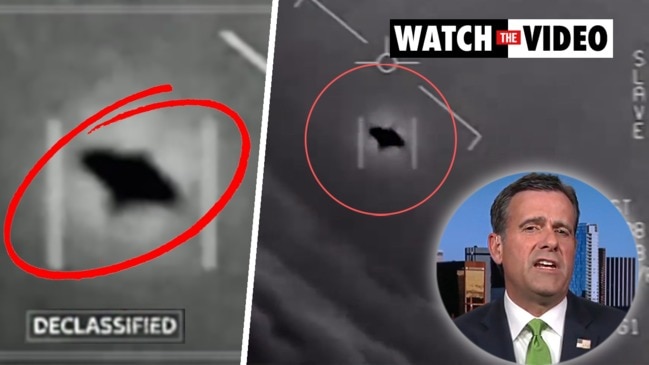
QWeekend
Don't miss out on the headlines from QWeekend. Followed categories will be added to My News.
The mystery begins about 7pm on a Wednesday night as Matthew Gardner prepares an ice-cream for his fiancee, Tenika Lawther. A waffle cone with vanilla ice-cream and chocolate sauce and sprinkles, delivered to “Tink” on the lounge at their Gympie home as they watch a bit of tele.
Gardner, 26, sits down between Lawther, 23, and their five-month-old daughter, Oceana, who is lying in a bouncer propped up on top of the lounge. Gardner isn’t seated long before his resolve vanishes. He’ll have some ice-cream, too.

He picks up Oceana, taking her with him to the kitchen bench, where he grabs a spoon to eat from the tub. Oceana gets her first, tiny taste. Then, bang, crack, pow.
An almighty noise fills the neat brick home. Lawther turns to see gyprock and dust falling like confetti from the ceiling. “What have you done?” she calls.
But Gardner is as stunned as Lawther. They look up to see a hole in the gyprock ceiling about the size of a 50-cent piece. They look down to see a small, turtle-shaped crack on the tiled floor. They look at each other: “What the hell was that?”
They go searching. Nothing. After about 10 minutes of looking under couches and behind curtains, Gardner peers into Oceana’s bouncer, at least two metres away from the chipped tile.
There’s a piece of metal in there. A compressed, silvery-grey thing about 3cm long with slightly jagged edges; smooth-ish on one side but with horizontal and vertical lines etched on the other.
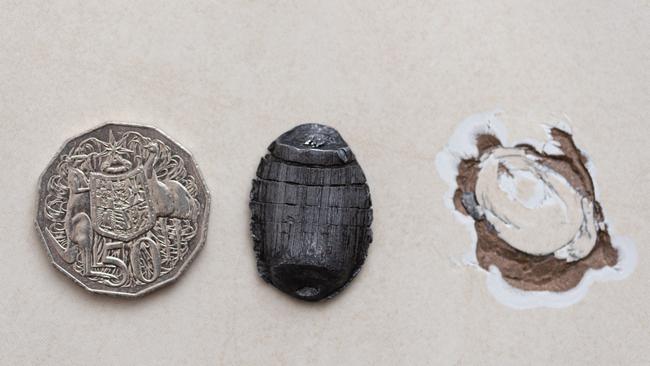
They’re horrified. What if Oceana had still been in the bouncer? “I don’t think she’d still be here,” says Lawther, “it came at such a speed.”
They call the police. Is someone firing at your house? Well, no, Lawther tells them. Gardner’s had a look and there’s a hole in the tin roof, almost directly above the hole in the gyprock ceiling.
“It’s come through the roof,” she says. Police don’t visit. They suggest it might have fallen off a plane.
Lawther puts it on Facebook. Media visit, and the story speeds around the globe. Ideas come flooding in.
Space junk, some say. Or, it’s a bullet. Others scoff, telling how they’ve been shooting for years and it looks nothing like a bullet. One bloke says it’s off a 747 aeroplane, a “silton use [sic] for the pally pod on the engine balancer”. Others, a 10mm socket. Or a space peanut. Aliens, one screams.
It’s bewildering and alarming and freaky and I’m hooked. I contact the couple about The Thing That Fell Through the Roof.

Quite understandably, the couple wants answers. They’re left discombobulated by the speed, the force of the projectile. They’re astounded by the odds of it zeroing in on their home – and Oceana not being hit.
“We’re the kind of people that try to find the meaning of things; everything happens for a reason,” says Gardner, a civil engineer. “We just haven’t quite figured this one out yet.”
Lawther, an aged care worker on maternity leave, has already fielded three offers to buy The Thing, the prospective owners convinced it’s space junk. A quick sale might pay for the insurance excess, Lawther jokes.

Space junk hitting Earthlings is not unheard of, but it’s rare.
In January 1997, Lottie Williams and some friends were out for a 4am stroll in a park in Tulsa, Oklahoma, when they saw a flaming ball hurtling towards Earth.
“We were stunned, in awe,” Williams said of the light show. “It was beautiful.”
About 30 minutes later, Williams felt something hit her shoulder, then it hit the ground. She picked up an oddly-shaped object about 15cm long that resembled mesh but sounded metallic when tapped.
It was space debris, part of a fuel tank from a Delta II rocket that launched a satellite in 1996.
Larger parts of the rocket were found several hundred kilometres away in Texas, reminiscent of the slab of Skylab that hit Western Australia in 1979.
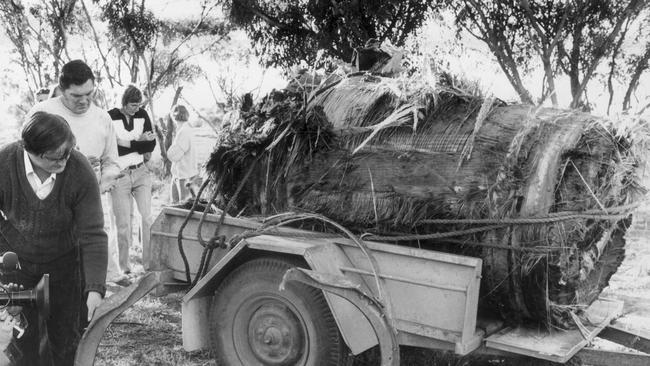
Williams had become one of a handful of people, and the only named person, to be hit by space debris.
The amount of junk in space has exploded in the past 25 years, as the final frontier becomes the Wild West.
There are millions and millions of bits of stuff – rocket parts, dead satellites, flecks of paint – hurtling around in the great junkyard of space.
Fred Menk, chair of the Australian Academy of Science’s National Committee for Space and Radio Science, says about 23,000 items are currently being tracked by scientists. But that’s just the ones they’re most worried about.
“It’s estimated there is something like a million objects, junk, debris of a centimetre and larger, orbiting around Earth. Smaller than that would be a huge number.”

If bits do break free of what is called Low Earth Orbit and plummet through the atmosphere, we rarely see them. With oceans covering 70 per cent of the planet, junk can plop into the vastness unnoticed.
Mostly, it burns up before getting that far. “It’s a fiery re-entry,” Menk says. “So the chance of something landing on your house is really, really small. But it’s not impossible.”
Menk takes a look at the photographs Lawther supplied. He’s looking for scorch marks. He doesn’t find any.
“If it’s charred or scorched, then it’s re-entered the atmosphere and it’s come from space,” he says. “But if it’s not, it’s probably come from a plane.”
Menk’s adjudication is backed by the Australian National University’s Dr Brad Tucker, an astrophysicist and cosmologist at Mt Stromlo Observatory, outside Canberra.
Three things make him discount space junk: no sign of melting or friction, the fact debris that size would have done “a lot more damage due to the speed [it would be] travelling”, and because no other stray bits have been reported.

It’s a similar answer from Dr Cassandra Steer, the deputy director of the ANU Institute for Space. But she’s fascinated.
She shows it to a colleague with more technical expertise. The colleague agrees, adds she doesn’t think it’s a bullet, and reasons that “the sharp edges looks more as if this piece has ripped off somewhere during some form of material fatigue, more likely from an aeroplane”.
Things do fall off aeroplanes, too. There’s even a term for it: PDA, or parts departing from aircraft.
Perhaps the best-known recent case was not so much a part, more a byproduct. A man strolling in his garden near Windsor Castle was splattered by faeces after it leaked from an aeroplane approaching nearby Heathrow Airport last year.
Such a leakage is rare and normally freezes; the warm weather was blamed for it reaching the ground “as a more ‘fluidy’ item”.
But also last year, an engine cowling, about 4.5m in diameter, fell into the front yard of a home near Denver, Colorado, and the next day, two people were injured in the Dutch town of Meerssen after engine pieces left a cargo plane.
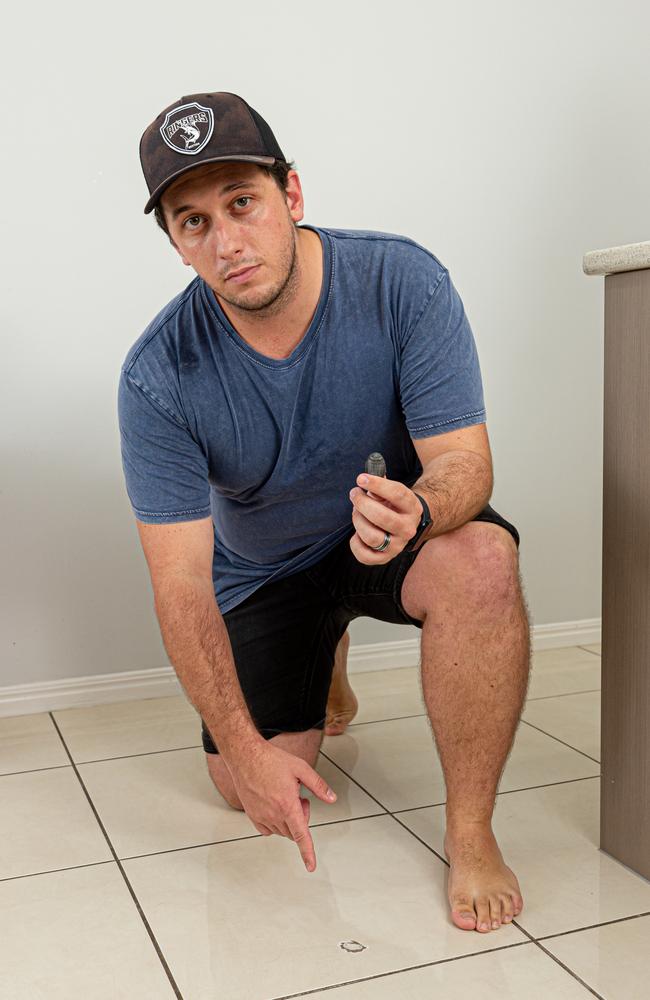
Evacuation slides, doors, service panels, aluminium skins and turbine blades have all plummeted to the ground in different parts of the world.
It’s not something authorities like to talk about, and despite contacting a range of aviation maintenance companies, flying schools and the Australian Licensed Aircraft Engineers’ Association, no one wanted to comment.
The Australian Transport Safety Bureau says it’s logged 465 cases of objects falling from planes since mid-2003, which works out to about 24.5 a year. Twenty were investigated.
However, Gympie, is not beneath the flight path of commercial airlines and only a couple of planes were in the area at the time, although at least 6km away.
The hunt for answers was getting cold.
Other-worldly possibilities came to the fore in the middle of last month as Pentagon officials told the US Congress of 144 documented sightings of unidentified flying objects – or the official term, unidentified aerial phenomena – being observed by military personnel between 2004 and last year.
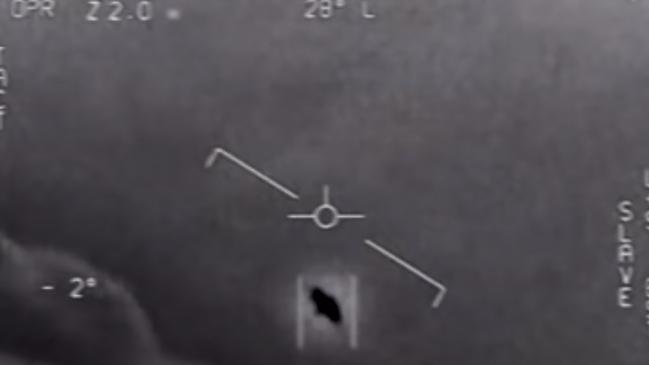
They may be out there but there were no reports of mysterious objects zipping above Gympie on Wednesday, May 4, let alone losing a bit, so I turn attention to more earthly pursuits. I call Ron Owen, the shooting enthusiast who drew the ire of many for his fierce campaign against Australia’s gun law reforms following the Port Arthur massacre.
He’s had his gun shop in Gympie since 1980. He’s eager to see “The Thing”.
IS IT A BULLET?
Tenika Lawther walks into Owen’s shop withOceana on her hip, glancing left and right at the rows of guns. It’s Lawther’s first time inside a gun shop and she’s a little “freaked out” but keen to take up Owen’s offer to test The Thing to determine its metallurgical make-up.
She reaches into a purse and extracts the 27g lump. “Everyone says it’s a bullet but it’s not, is it?” she says to Owen. The big man takes one look.
“That’s a large, lead projectile,” he says. In other words, a bullet.

Lawther is aghast. “Oh my God,” she says. A small posse gathers around, the news of the arrival of The Thing having spread. “Is that the thing that fell through the roof?” says one worker. “Hooley-dooley!”
The questions come thick and fast. What calibre would it be? “I’d say about 45 or 50 cal,” says Owen.
Why does it look like that? “It’s hit something hard and flattened out …it’s a lead bullet that’s gone up a long way and, unfortunately, come down through the roof. It’s come down sideways, not nosedown, through the roof and then hit your tiles.”
Adds Lawther: “And then bounced two metres!” Says Owen: “Wow!”
He puts it on a magnet. It doesn’t stick. Lead isn’t magnetic. He puts it under the hardness tester. It won’t register. Lead is too soft. There’s no doubt in his mind it’s a bullet.
Owen gets up and guides us into his gun museum, moving towards a glass cabinet displaying a range of shooting paraphernalia.
“Your bullet is something like that,” he tells Lawther, indicating a squat and thick bullet, with rings around the base and a blunt point.

Those rings are lubrication lines pressed into the bullet when it’s made and, Owen says, the source of the horizontal lines on The Thing. The vertical lines would be from the rifling grooves when it was shot.
Lawther lets out a sigh. “It’s so lucky it didn’t kill us, honestly,” she says. “Oh God, it freaks me out.”
Owen directs us towards the type of old-style rifle he believes would have fired it. “Something like that,” he says. “A Martini-Henry 577/450.”
He explains they’re a single-shot rifle, either cartridge or muzzleloading, that use black powder and were popular around the 1870s.
“The only things that shoot those big lead bullets are from our past, and there’s still thousands of them,” Owen says. “They generally use them for things like pigs.”
That’s not entirely true, says Ben Eu, a ballistics expert I speak with later. He agrees The Thing is a lead bullet, but the general manager of Melbourne-based Ballistic and Mechanical Testing says there are modern versions of the rifle, such as the Italian-made Pedersoli.
“It’s not uncommon to see recent production of muzzleloading firearms and people using their own cast projectiles,” he says.

Owen believes if there wasn’t a lot of powder used, thus reducing the velocity, the bullet “could have come from the end of your street”, but adds it could have been fired from kilometres away.
Eu differs on that, too. Whether it’s from an old or new version, says Eu, “I’d have some serious concerns as to whether it could travel a kilometre. They’re designed as very close-range firearms, so 100m.”
There are so many questions with so many variables. Was it fired up in the air or at an angle? Did it hit something and ricochet?
If it was close by, why didn’t they hear a shot? And why does it appear to have come straight down from roof to ceiling, not at an angle, as a bullet would be expected to?
But the question really bugging Lawther now is: “Where did it come from?” She knows there’s a rifle range at the back of her home, about 1.3km away as the crow flies. They shoot on a Wednesday night. “From the rifle range, then?” she asks Owen, a regular at the range.
He shakes his head. “We’re only allowed to shoot .22s,” he says, showing Lawther a much smaller .22 bullet. “Things that would shoot something like [The Thing], they’re not allowed anywhere near our rifle range.”

Amanda Long, president of the Gympie Small Bore Rifle and Silhouette Club, later confirms this. Nothing of that calibre is allowed on the range. It is policed.
The range has banking at the rear of targets to “capture any stray leads”. On a “really good day” the types of weapons they shoot – using a .22 projectile – would go 1km at the most.
She has no need to relook at protocols; she is completely confident the bullet could not have come from the range.
But does Owen have an inkling who might use such a gun? He’s been around these parts for decades, must know every gun owner in the district.
First up, Owen says, he doesn’t know every gun owner in Gympie. “There’s 28,000 licensed gun owners in Gympie.” Secondly, if he knew who it was, he’d have no hesitation telling Lawther.
“So we’ve got Buckley’s finding out where it’s from, then?” asks Lawther.
Owen: “Absolutely.”
Lawther rushes home to fill Gardner in on what she’s learned from Owen, nipping into a bedroom to change Oceana’s nappy.
“And you know what?” she calls. “There’s a gun called Oceania. Our daughter is called Oceana and she nearly gets hit by a bullet in her own house!”

“What are the odds?” says Matt.
Indeed. Quite fantastic odds all around.
They know what The Thing is now but their quest to know who fired it, and the meaning of its arrival, remains. It doesn’t seem to mean that they’ll come into money: a Lotto ticket they bought delivered nothing, they can’t sell it as space junk, and they’ve got $600 in excess to pay on their insurance.
But they’ve been buoyed by the support of the Gympie community. A local tiler even offered to fix the floor for free.
So, they’re staying in their modest suburban home with a tin roof that became the strike zone for a bullet from who knows where as they were relaxing with their daughter, eating ice-cream.
But, says Lawther, bouncing The Thing in her hand before popping it away for safekeeping: “I said to Matt, ‘If it happens again, that’s it. We’re out’.”




